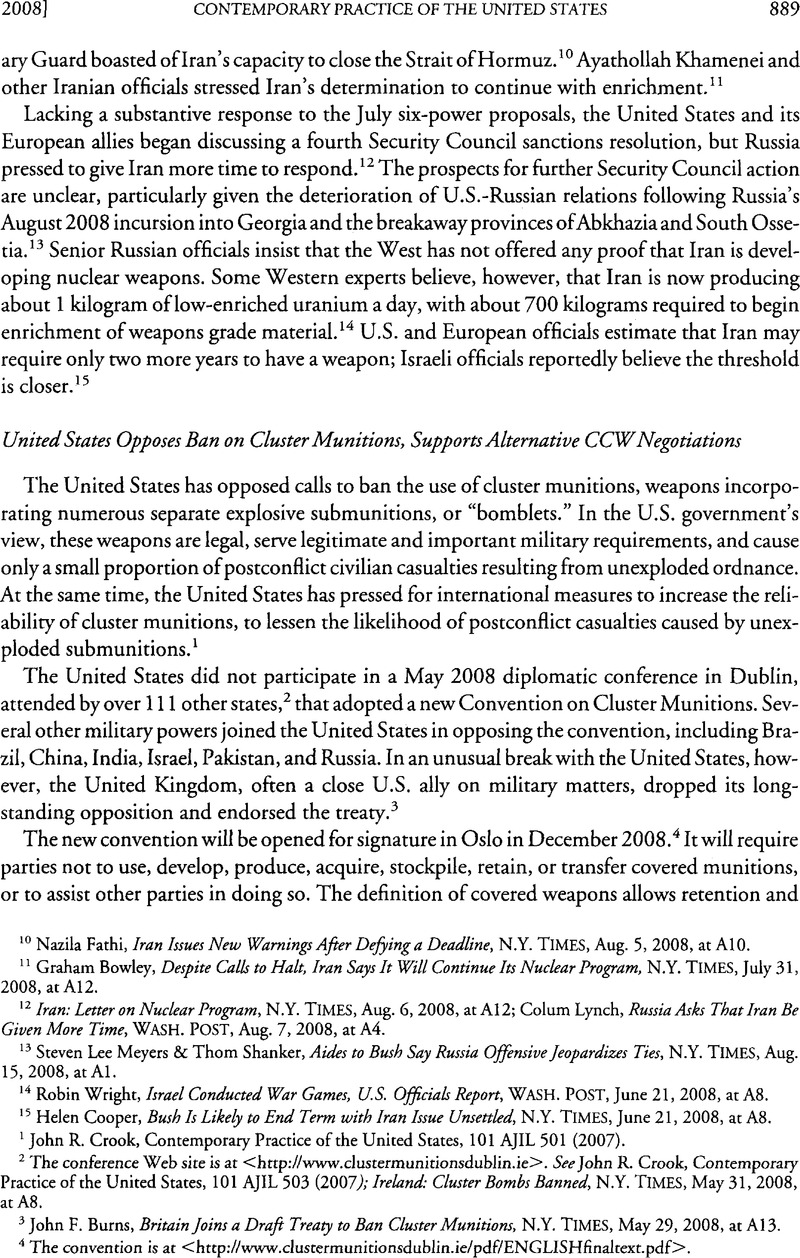No CrossRef data available.
Article contents
United States Opposes Ban on Cluster Munitions, Supports Alternative CCW Negotiations
Published online by Cambridge University Press: 10 March 2017
Abstract

- Type
- Contemporary Practice of the United States Relating to International Law
- Information
- Copyright
- Copyright © American Society of International Law 2008
References
1 John, R. Crook Contemporary Practice of the United States, 101 AJIL 501 (2007).Google Scholar
2 The conference Web site is at <http://www.clustermunitionsdublin.ie>. See John, R. Crook Contemporary Practice of the United States, 101 AJIL 503 (2007)Google Scholar; Ireland: Cluster Bombs Banned , N.Y. Times, May 31, 2008, at A8.Google Scholar
3 John, F. Burns Britain Joins a Draft Treaty to Ban Cluster Munitions , N.Y. Times, May 29, 2008, at A13.Google Scholar
4 The convention is at <http://www.clustermunitionsdublin.ie/pdf/ENGLISHfinaltext.pdf>.
5 Article 2(2) of the convention defines the covered weapons:
“Cluster munition” means a conventional munition that is designed to disperse or release explosive submunitions each weighing less than 20 kilograms, and includes those explosive submunitions. It does not mean the following:
-
(a)
(a) A munition or submunition designed to dispense flares, smoke, pyrotechnics or chaff; or a munition designed exclusively for an air defence role;
-
(b)
(b) A munition or submunition designed to produce electrical or electronic effects;
-
(c)
(c) A munition that, in order to avoid indiscriminate area effects and the risks posed by unexploded submunitions, has all of the following characteristics:
-
(i)
(i) Each munition contains fewer than ten explosive submunitions;
-
(ii)
(ii) Each explosive submunition weighs more than four kilograms;
-
(iii)
(iii) Each explosive submunition is designed to detect and engage a single target object;
-
(iv)
(iv) Each explosive submunition is equipped with an electronic self-destruction mechanism;
-
(v)
(v) Each explosive submunition is equipped with an electronic self-deactivating feature[]
-
(i)
6 Protocol on Explosive Remnants of War (Protocol V) to Convention on Prohibitions or Restrictions on the Use of Certain Conventional Weapons Which May Be Deemed to Be Excessively Injurious or to Have Indiscriminate Effects, Nov. 28, 2003, at <http://www.ccwtreaty.com/KeyDocs/Protocol-V-E.pdf>; see John, R. Crook Contemporary Practice of the United States, 101 AJIL 501, 502 (2007).Google Scholar
7 Foster, Klug Official: Cluster Bomb Ban Could Hurt Cooperation (May 21, 2008), at <http://apnews.myway.com/article/20080521/D90QAL7O0.html>..>Google Scholar
8 The June 19, 2008, policy document, a memorandum from the secretary of defense to the secretaries of the military departments, the chairman of the joint chiefs, and other senior Defense Department officials, is at <http://www.defenselink.mil/news/d20080709cmpolicy.pdf>.
9 U.S. Dep’t of Defense News Release No. 577–08, Cluster Munitions Policy Released (July 8, 2008), at <http://www.defenselink.mil/releases/release.aspxFreleaseid=12049>>Google Scholar.




